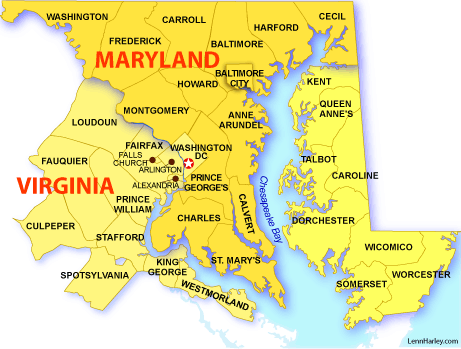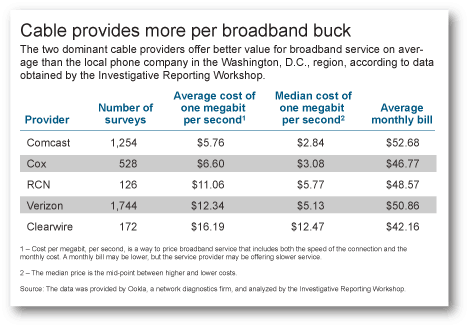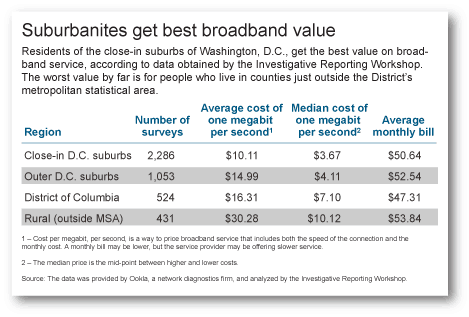 Inner city Americans pay substantially more for broadband service than their neighbors in wealthy suburbs, while rural America pays the highest prices of all for broadband service, according to the results of a new study.
Inner city Americans pay substantially more for broadband service than their neighbors in wealthy suburbs, while rural America pays the highest prices of all for broadband service, according to the results of a new study.
The Investigative Reporting Workshop at American University analyzed broadband speeds and service around the nation’s capital to learn how broadband is priced in different neighborhoods and communities. The study covered the eighth largest metro area, which included over five million residents in the District of Columbia, Maryland, and Virginia.
Broadband providers never release specific data about their customers’ broadband service and the prices they pay for it, considering it a closely guarded business secret. The Workshop went direct to consumers to get around this limitation, combining actual speed test results with the true cost of standalone broadband service reported by study participants. It’s among only a handful of studies that rely on actual raw performance and pricing data — not company-provided general marketing information about speeds and pricing.
The conclusions expose a dramatic difference in broadband pricing depending on where one lives, what company they do business with, and how well each company’s network performs.
The results? Broadband pricing was cheapest from Comcast, the region’s dominant cable company and most expensive, by far, from a wireless ISP (WISP) that serves the Culpepper, Virginia area. Residents in wealthy suburbs in Fairfax County, Virginia and Montgomery County, Maryland enjoyed the best bang for their buck, charged nearly half the price-per-megabit that residents inside the urban District of Columbia pay. Rural residents were stiffed with high prices for comparatively slow speed service.
 Verizon, the area’s dominant phone company did poorly in the study, in part because of the substantial number of legacy DSL customers who are paying a lot for little speed. Although Verizon’s fiber-optic FiOS service is making inroads in some parts of the study area, its high speeds don’t reach enough customers to offset Verizon’s larger base of DSL customers.
Verizon, the area’s dominant phone company did poorly in the study, in part because of the substantial number of legacy DSL customers who are paying a lot for little speed. Although Verizon’s fiber-optic FiOS service is making inroads in some parts of the study area, its high speeds don’t reach enough customers to offset Verizon’s larger base of DSL customers.
Here’s how Comcast and Verizon compared:
- Comcast, according to an average of 1,254 surveys, charged customers $5.76 per Mbps;
- Verizon, according to 1,744 surveys, charged $12.34 per Mbps — more than twice as much as Comcast.
- Verizon charged $50.86 per month on average.
- Comcast charged $52.68.
- The median, or midpoint price, is much lower, at $5.13 per Mbps for Verizon and $2.84 for Comcast.
Cox Communications, a cable company that serves Fairfax County and Fredericksburg in Northern Virginia, charges $6.60 per Mbps, according to 528 surveys. Cox’s monthly average cost was $46.77.
Rounding out the five regional providers, RCN Corp., averaged $11.06 per Mbps, or $48.57 per month, for a median price of $5.77 per Mbps, according to 126 surveys, and Clearwire Corp., according to 172 surveys, averaged $16.19 per Mbps for $42.16 per month and a median price of $12.47 per Mbps.
 By far the worst values went to rural customers. Overall, the study found rural residents pay $30.28 per Mbps (based on 431 surveys) and $53.84 per month for service, a per-megabit rate far higher than the other three regions.
By far the worst values went to rural customers. Overall, the study found rural residents pay $30.28 per Mbps (based on 431 surveys) and $53.84 per month for service, a per-megabit rate far higher than the other three regions.
Virginia Broadband LLC, a Culpeper, wireless broadband provider, offered the worst value. According to a summary of 24 surveys, the company charges a whopping $198.13 per Mbps, the most of any company that underwent more than one test. The average monthly bill was $94.07, and the average speed was less than a megabit per second.
Comcast, RCN, and Virginia Broadband did not respond or refused to comment. Verizon said the results were unfair because it did not distinguish between FiOS fiber to the home customers and their traditional DSL service.
They also criticized the study’s price comparisons, which relied solely on standalone broadband service pricing. Verizon, like most providers, discounts services to customers who choose to bundle their telecommunications products together.
The study arrives at the same time the federal government has released their own national broadband map, which relies to a large degree on information volunteered by broadband providers.
The study has been criticized for not accurately depicting true broadband speeds and pricing, which can distort the true picture of broadband availability across the United States.


 Subscribe
Subscribe